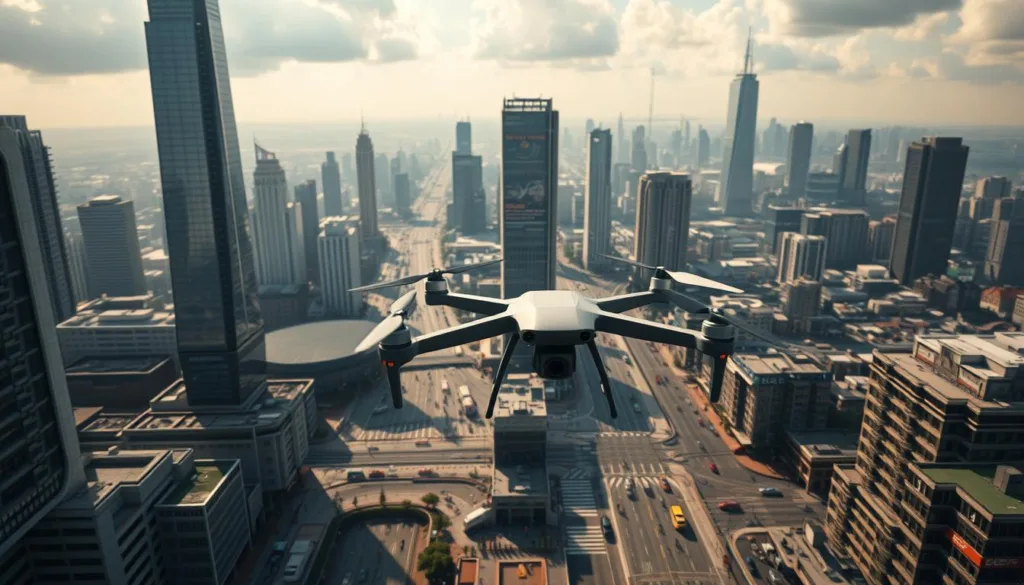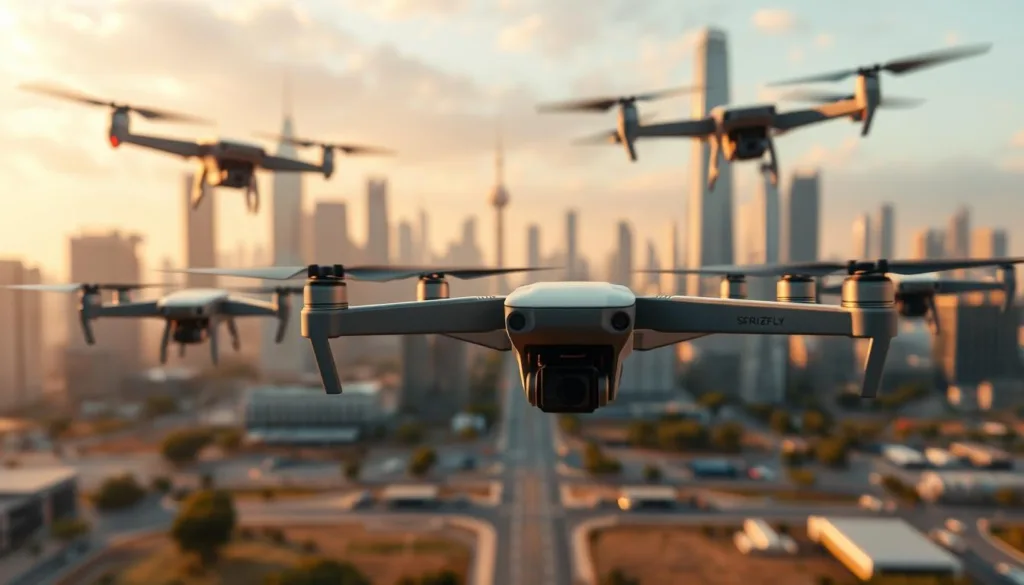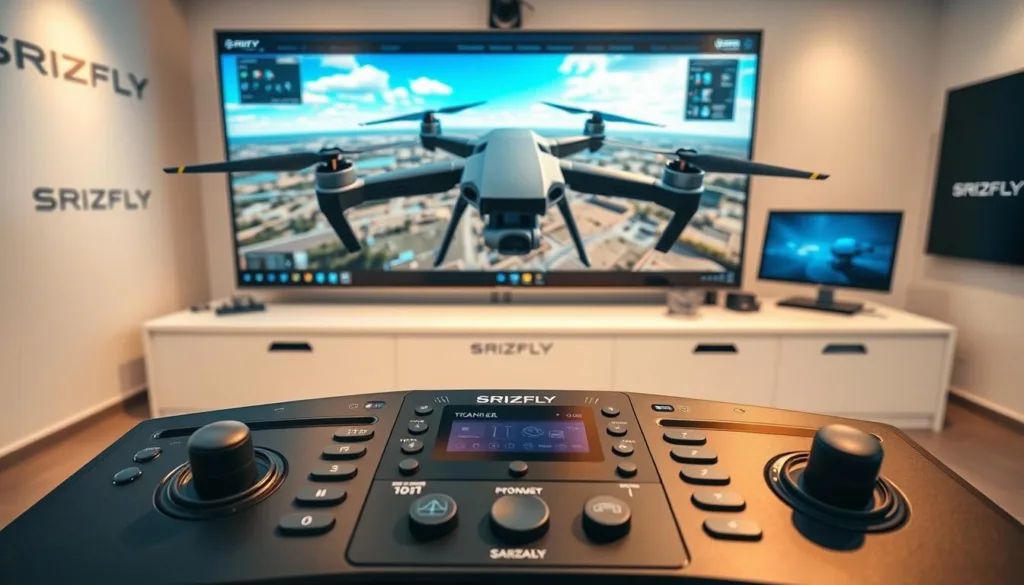Modern drone operations demand precision, safety, and adaptability. Specialized training platforms now bridge the gap between classroom theory and real-world challenges, offering lifelike practice environments for pilots. These tools eliminate weather restrictions, equipment costs, and operational risks while accelerating skill development.
One leading solution replicates diverse flying conditions through detailed digital landscapes and aircraft models. Users master everything from basic maneuvers to emergency protocols through scenario-based modules. The system’s physics engine mirrors actual drone behavior, creating muscle memory that translates directly to field operations.
With official support shifting to new partners in 2024, organizations gain future-proof access to updated features and hardware compatibility. This transition ensures continuous improvement for teams using popular commercial drones and controllers. Training managers appreciate the platform’s progress tracking and customizable difficulty settings.
Key Takeaways
- Realistic practice environments reduce training costs and accident risks
- Multiple drone models and weather conditions available digitally
- Seamless transition to updated support systems coming in 2024
- Skill-building modules for all experience levels
- Performance analytics to track pilot development
Introduction to DJI Simulator Enterprise
High-stakes drone operations require more than just theoretical knowledge. The right training platform turns complex maneuvers into second nature while slashing real-world risks. This is where advanced flight simulation shines, offering lifelike practice without weather delays or equipment costs.
Overview and Purpose
Built for skill mastery, this solution bridges classroom lessons and field expertise. Users navigate digital replicas of popular aircraft through challenging scenarios – think gusty winds or equipment malfunctions. One fire department training lead notes:
“Our teams now practice emergency landings weekly without touching actual drones.”
The system’s physics engine mimics real device behavior, from battery drain to wind resistance. Customizable modules progress from basic hovering to advanced mission planning, creating adaptable pilots ready for anything.
Target Users and Applications
Emergency responders, agricultural surveyors, and film crews all benefit from risk-free rehearsals. Schools use it to train new pilots, while construction firms simulate site inspections. Features like group sessions and progress dashboards make it ideal for organizations scaling their drone programs.
From precision agriculture to infrastructure checks, the platform prepares teams for sector-specific challenges. As one energy company manager puts it: “We’ve cut field training time by 40% while improving safety metrics.”
DJI Simulator Enterprise: In-Depth Features
Mastering unmanned aircraft operations requires tools that mirror real-world complexity. This training platform combines technical precision with adaptable learning paths, helping pilots refine skills faster than traditional methods. Let’s explore what sets its functionality apart.
Key Functionality and Capabilities
Three specialized flight modes adapt to different expertise levels. P-mode introduces basic controls, while A-mode adds automated features for intermediate practice. S-mode unlocks full manual settings, challenging seasoned operators to handle advanced maneuvers.

The physics engine replicates real aircraft behavior down to battery drain rates. Wind resistance and terrain interactions feel authentic, building muscle memory for field operations. Custom scenarios let teams rehearse everything from infrastructure inspections to emergency landings.
Simulation Environments and Drone Models
Over 15 professional-grade aircraft are digitally replicated, including popular Mavic and Phantom series. Pilots train on the exact models they’ll use onsite, ensuring seamless transitions to physical drones.
Virtual landscapes range from urban skylines to mountainous regions, with adjustable weather like rainstorms or fog. One utility company trainer notes: “Our crews now practice power line inspections in gale-force winds—something we’d never risk with actual equipment.”
Key Specifications and System Requirements
Technical specifications shape the quality of virtual training. Before diving into practice sessions, understanding your setup ensures smooth performance and realistic simulations. Let’s explore what your computer needs to handle advanced flight scenarios.
Hardware Essentials
The platform offers three performance tiers to match different budgets. Entry-level systems need a Pentium G4560 processor and GTX 1050 Ti graphics card. This setup handles basic maneuvers but may struggle with complex weather effects.
Most teams prefer the mid-range configuration. An Intel i5 chip paired with a GTX 1080 Ti delivers crisp visuals during inspections or emergency drills. For studios running multiple simulations daily, the premium build with an i7 processor and RTX 2080 ensures flawless rendering.
Software Foundations
Windows 10 64-bit acts as the backbone for all operations. This software environment maximizes stability while supporting detailed physics calculations. One training coordinator shares: “Since switching to 64-bit systems, we’ve eliminated crashes during critical drills.”
Storage plays a bigger role than many realize. Solid-state drives cut loading times by half compared to traditional hard disks. Whether you choose 16GB or 32GB RAM depends on how many applications run alongside your training modules.
Advanced Training Modes and Customization Options
Effective pilot development thrives on adaptable practice environments. Three core modes address different skill levels while letting teams tailor exercises to their operational needs. Whether mastering basics or rehearsing high-pressure missions, these tools build confidence through controlled challenges.

Free Flight Mode and Mission Planning
New operators start with unrestricted exploration. This sandbox-style environment removes waypoints and time limits, perfect for practicing smooth takeoffs or perfecting camera angles. “It’s like having a digital playground where mistakes don’t cost thousands in repairs,” notes an aerial photography instructor.
Mission Planning Mode shifts focus to precision. Users plot routes through virtual obstacles, adjusting altitudes and speeds for tasks like crop monitoring. Realistic battery life calculations and wind patterns force strategic thinking – skills that translate directly to field operations.
Emergency Response and Custom Flight Parameters
Teams preparing for search rescue missions face simulated disasters. Imagine locating avalanche survivors while battling sudden snowstorms. These modules include equipment failure scenarios, teaching pilots to troubleshoot mid-flight.
Customization extends to every flight parameter. Adjust wind speeds to match local weather patterns or limit maximum altitude for urban drills. One fire department captain shares: “We recreate last year’s wildfire conditions so new recruits learn from past challenges.”
Progress tracking shows skill growth across training sessions. Difficulty scales automatically as pilots demonstrate mastery, ensuring continuous improvement without overwhelming learners.
Realistic Flight Environments and Multi-User Collaboration
Dynamic training tools now recreate the unpredictable nature of real-world operations. Teams develop critical decision-making skills through shared virtual spaces where weather patterns shift mid-flight and teammates coordinate complex tasks.
Live Weather Simulation
Imagine practicing landings as sudden crosswinds push your aircraft sideways. The system generates live meteorological challenges, from drizzles to thunderstorm gusts. One coastal rescue trainer explains: “We drill water rescues in hurricane conditions that would ground actual drones.”
Pilots learn to interpret real-time weather radar displays while adjusting flight paths. Fog reduces visibility to 15 feet, demanding reliance on instrument readings. These scenarios build adaptability for agricultural surveys or emergency response missions.
Flight Data Recording for Post-Session Analysis
Every virtual flight becomes a learning opportunity with detailed performance logs. The platform tracks 47 metrics, including battery consumption rates and stabilization errors. Training managers spot trends through color-coded dashboards showing altitude deviations or camera gimbal adjustments.
After a simulated power line inspection, teams review:
“Why did Pilot A’s battery drain 22% faster than Pilot B’s? The data showed unnecessary hovering.”
Multi-user sessions add depth to these reviews. Three pilots can simultaneously analyze their approaches to the same search grid, comparing route efficiency and obstacle avoidance tactics.
Integrating DJI Simulator with Hardware and Controllers
Seamless hardware integration transforms virtual training into real-world expertise. By pairing physical gear with digital environments, pilots build muscle memory using the exact tools they’ll operate in the field. This connection bridges the gap between practice sessions and actual missions.
Supported Controllers and Devices
The system works with popular remote models like Phantom 4 and Matrice series. Mavic Air users enjoy full compatibility, replicating their controller’s layout and response times. Simply plug in your device via USB cable to start training.
Most setups connect in under a minute. The platform recognizes stick movements, button presses, and gimbal adjustments instantly. This lets pilots focus on skill development rather than tech troubleshooting.
Calibration Procedures for Accurate Simulation
Precision begins with proper calibration. The software guides users through a quick three-step process to align controller inputs. Adjust stick sensitivity or camera tilt speed to match your preferred flying style.
Regular recalibration ensures virtual drones respond exactly like their physical counterparts. One cinematography trainer notes: “After fine-tuning our Mavic Air settings, trainees nail complex aerial shots faster.” These tweaks make every simulated flight count toward real-world mastery.
FAQ
Who benefits most from using this training tool?
Professionals like pilots conducting power line inspections, search and rescue teams, and industrial operators gain the most. It’s ideal for mastering complex flight scenarios with models like the Matrice 200 series or Mavic Air.
Can I practice emergency procedures with this software?
Yes! Custom flight parameters let you simulate equipment failures, sudden weather changes, or high-pressure missions. This prepares crews for real-world challenges in search and rescue operations.
What controllers work with the training platform?
It supports DJI’s standard remote controllers, including those for the Matrice and Mavic series. Calibration tools ensure seamless integration for lifelike practice sessions.
Does the system mimic real weather conditions?
Absolutely. Live wind, rain, and lighting effects are included. Teams can rehearse missions in environments matching their actual fieldwork locations.
How does post-session analysis improve skills?
Flight data recordings track every maneuver, letting crews review performance metrics. This helps refine techniques for tasks like infrastructure inspections or aerial mapping.
What computer specs are needed to run the software smoothly?
A Windows 10 64-bit system with at least 16GB RAM and a dedicated GPU (NVIDIA GTX 1060 or higher) is recommended. Solid-state drives ensure faster load times for detailed environments.
Can multiple users collaborate during training exercises?
Yes. Teams can work together in shared virtual spaces, perfect for coordinating roles during complex missions like disaster response or large-scale surveys.



